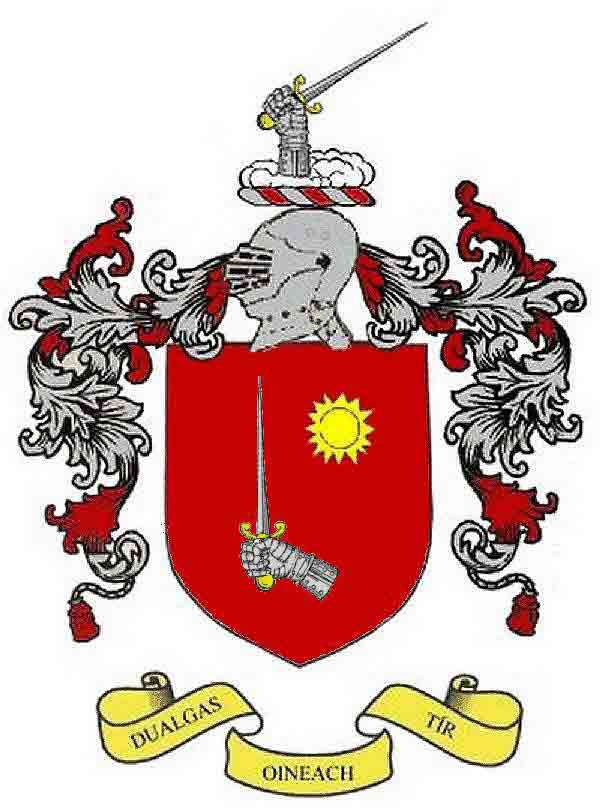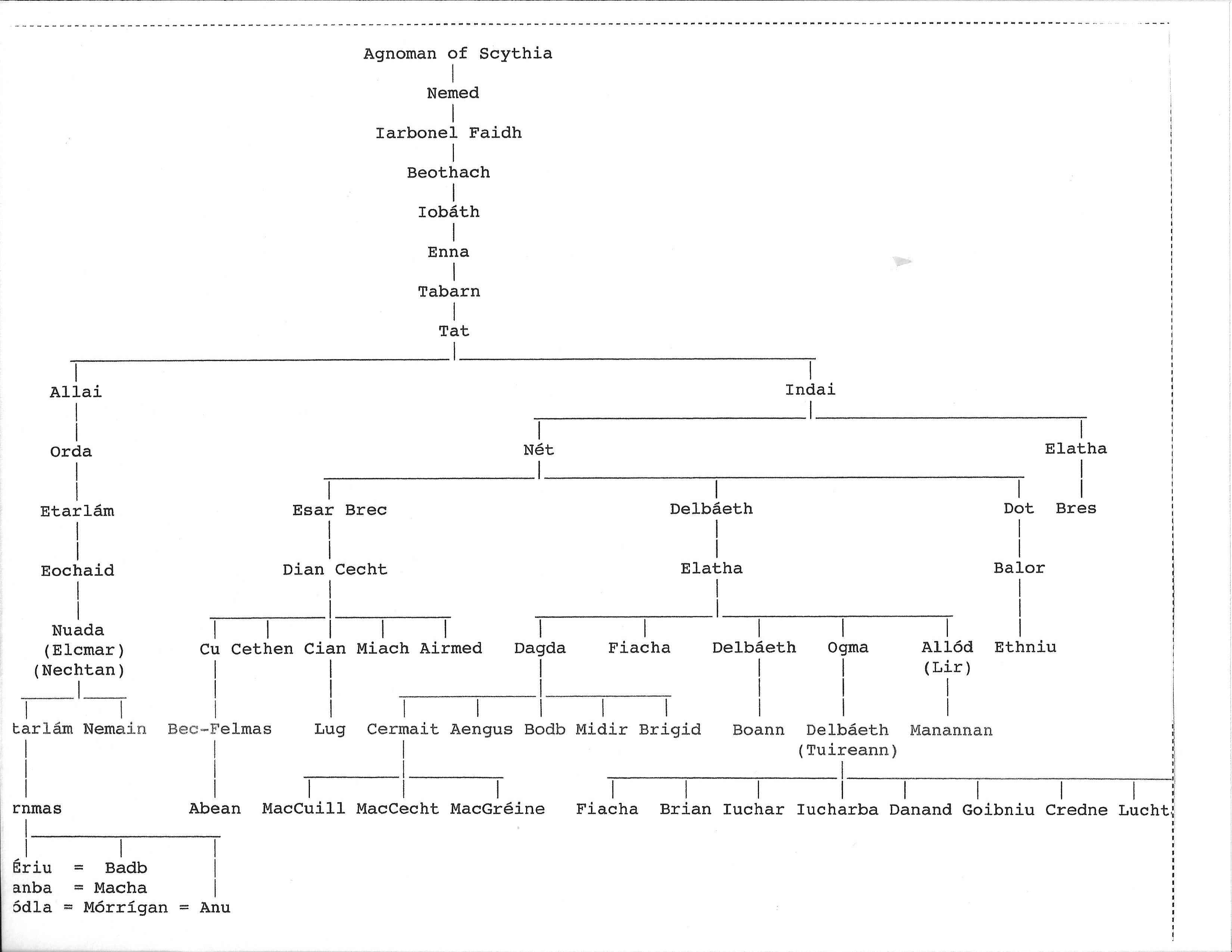
"Tuatha De Dannan"
(People/tribes of the goddess Danu)
The Tuath(a) Dé Danann (usually translated as "people(s)/tribe(s) of the goddess Danu"), also known by the earlier name Tuath Dé ("tribe of the gods"),[1] are a race of supernaturally-gifted people in Irish mythology. They are thought to represent the main deities of pre-Christian Gaelic Ireland.
Much of Irish mythology was recorded by Christian monks, who modified it to an extent. They generally depicted the Tuath Dé as kings, queens and heroes of the distant past who had supernatural powers or who were later credited with them. However, some writers acknowledged that they were once worshipped as gods. A poem in the Book of Leinster lists many of them, but ends "Although [the author] enumerates them, he does not worship them". Goibniu, Credne and Luchta are referred to as Trí Dé Dána ("three gods of craftsmanship"),[2] and the Dagda's name is interpreted in medieval texts as "the good god". Even after they are displaced as the rulers of Ireland, characters such as Lugh, the Morrígan, Aengus and Manannán mac Lir appear in tales set centuries later, showing all the signs of immortality. They also have parallels in the pantheons of other Celtic peoples: for example Nuada is cognate with the British god Nodens; Lugh is a reflex of the pan-Celtic god Lugus; Tuirenn is related to the Gaulish Taranis; Ogma to Ogmios; and the Badb to Catubodua.
Name
The Old Irish word tuath (plural tuatha) means "people, tribe, nation"; dé is the genitive case of día and, depending on context, can mean "god, gods, goddess" or more broadly "supernatural being, object of worship".[3] In the earliest writings, the mythical race are referred to as the Tuath Dé (plural Tuatha Dé).[1] However, Irish monks also began using the term Tuath Dé to refer to the Israelites,[1] with the meaning "People of God".[4] Apparently to avoid confusion with the Israelites,[1] writers began to refer to the mythical race as the Tuath Dé Danann (plural Tuatha Dé Danann). The Old Irish pronunciation is [t?uaθa d??e? d?anan?] and the Modern Irish pronunciation is [t??u?(hi) d?e? d??an??n??] in the West and North, and [t??u?h? d?e? d??an???n??] in the South. A rough English approximation is too?(h?) day dan?n or too?(h?) jay dan?n.
Danann is generally believed to be the genitive of a female name, for which the nominative case is not attested. It has been reconstructed as Danu, of which Anu (genitive Anann) may be an alternative form.[1] Anu is called "mother of the Irish gods" by Cormac mac Cuilennáin.[1] This may be linked to the Welsh mythical figure Dôn.[1] Hindu mythology also has a goddess called Danu, who may be an Indo-European parallel. However, this reconstruction is not universally accepted.[5] It has also been suggested that Danann is a conflation of dán ("skill, craft") and the goddess name Anann.[1] The name is also found as Donann and Domnann,[6] which may point to the origin being proto-Celtic *don, meaning "earth"[1] (compare the Old Irish word for earth, doman). There may be a link with the mythical Fir Domnann[7] and the British Dumnonii.[8]
Legendary history
The Tuatha Dé Danann were descended from Nemed, leader of a previous wave of inhabitants of Ireland. They came from four cities to the north of Ireland–Falias, Gorias, Murias and Finias–where they acquired their magical skills and attributes. According to Lebor Gabála Érenn, they came to Ireland "in dark clouds" and "landed on the mountains of [the] Conmaicne Rein in Connachta; and they brought a darkness over the sun for three days and three nights". According to a later version of the story, they arrived in ships on the coast of the Conmaicne Mara's territory (modern Connemara). They immediately burnt the ships "so that they should not think of retreating to them; and the smoke and the mist that came from the vessels filled the neighboring land and air. Therefore it was conceived that they had arrived in clouds of mist".
A poem in the Lebor Gabála Érenn says of their arrival:
It is God who suffered them, though He restrained them
they landed with horror, with lofty deed,
in their cloud of mighty combat of spectres,
upon a mountain of Conmaicne of Connacht.
Without distinction to descerning Ireland,
Without ships, a ruthless course
the truth was not known beneath the sky of stars,
whether they were of heaven or of earth.
Led by their king, Nuada, they fought the First Battle of Magh Tuireadh on the west coast, in which they defeated and displaced the native Fir Bolg, who then inhabited Ireland. In the battle, Nuada lost an arm to their champion, Sreng. Since Nuada was no longer "unblemished", he could not continue as king and was replaced by the half-Fomorian Bres, who turned out to be a tyrant. The physician Dian Cecht replaced Nuada's arm with a working silver one and he was reinstated as king. However, Dian Cecht's son Miach was dissatisfied with the replacement so he recited the spell, "ault fri halt dí & féith fri féth" (joint to joint of it and sinew to sinew), which caused flesh to grow over the silver prosthesis over the course of nine days and nights.[9][10] However, in a fit of jealous rage Dian Cecht slew his own son. Because of Nuada's restoration as leader, Bres complained to his family and his father, Elatha, who sent him to seek assistance from Balor, king of the Fomorians.
The Tuatha Dé Danann then fought the Second Battle of Magh Tuireadh against the Fomorians. Nuada was killed by the Fomorian king Balor's poisonous eye, but Balor was killed himself by Lugh, the champion of the Tuatha Dé, who then took over as king.
A third battle was fought against a subsequent wave of invaders, the Milesians, from the northwest of the Iberian Peninsula (present day Galicia and Northern Portugal), descendants of Míl Espáine (who are thought to represent the Goidelic Celts). The Milesians encountered three goddesses of the Tuatha Dé Danann, Ériu, Banba and Fodla, who asked that the island be named after them; Ériu is the origin of the modern name Éire, and Banba and Fodla are still sometimes used as poetic names for Ireland.
Their three husbands, Mac Cuill, Mac Cecht and Mac Gréine, who were kings of the Tuatha Dé Danann at that time, asked for a truce of three days, during which the Milesians would lie at anchor nine waves' distance from the shore. The Milesians complied, but the Tuatha Dé Danann created a magical storm in an attempt to drive them away. The Milesian poet Amergin calmed the sea with his verse, then his people landed and defeated the Tuatha Dé Danann at Tailtiu. When Amergin was called upon to divide the land between the Tuatha Dé Danann and his own people, he cleverly allotted the portion above ground to the Milesians and the portion underground to the Tuatha Dé Danann. The Tuatha Dé Danann were led underground into the Sidhe mounds by Manannán mac Lir.
Tuatha Dé Danann family tree:
The following table is based on the genealogies given by Geoffrey Keating and in the Lebor Gabála Érenn, and references in Cath Maige Tuireadh. It is not clear whether the various Elathas and Delbáeths are meant to be different figures of the same name or different traditions regarding the genealogy of the same figure. It is also notable that Fomorians such as Elatha and Balor are closely related to the Tuatha Dé.

CLICK TO INLARGE!

To send comments and suggestions for improving this site or to add new information that may be useful to others, please drop me a line.

|